

Nude Descending a Staircase, No. 2. Painting by Marcel Duchamp Nude Descending a Staircase, No. 2 (French: Nu descendant un escalier n° 2) is a 1912 painting by Marcel Duchamp.
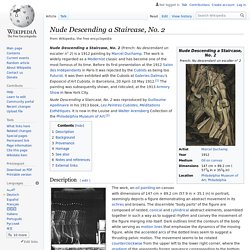
The work is widely regarded as a Modernist classic and has become one of the most famous of its time. Before its first presentation at the 1912 Salon des Indépendants in Paris it was rejected by the Cubists as being too Futurist. It was then exhibited with the Cubists at Galeries Dalmau's Exposició d'Art Cubista, in Barcelona, 20 April–10 May 1912.[1] The painting was subsequently shown, and ridiculed, at the 1913 Armory Show in New York City. Nude Descending a Staircase, No. 2 was reproduced by Guillaume Apollinaire in his 1913 book, Les Peintres Cubistes, Méditations Esthétiques.
Description[edit] Background[edit] Corresponding still photos by Eadweard Muybridge Duchamp submitted the work to appear with the Cubists at the 28th exhibition of the Société des Artistes Indépendants, Paris, 25 March through 16 May 1912. I said nothing to my brothers. File:Dido Elizabeth Belle.jpg. Christ Mocked. Painting by Cimabue Christ Mocked is a small 13th-century panel painting by the Italian artist Cimabue, in tempera on a poplar panel.

It depicts the Mocking of Jesus and is one of three panels known from a polyptych depicting the passion of Christ. It was discovered in a house in Northern France. In October 2019 it sold at auction for €24 million, a record for a pre-1500 artwork. It is believed to be the first work by Cimabue to have been auctioned. Description[edit] Christ Mocked measures 25.8 cm × 20.3 cm × 1.2 cm (10.16 in × 7.99 in × 0.47 in) and depicts the mocking of Jesus prior to his crucifixion.[1] The work is painted with egg tempera on a gold leaf background, on a thinned and slightly bowed poplar panel prepared with layers of gesso ground in which a canvas is embedded. An infrared reflectogram has revealed Cimabue's underdrawing. Discovery and sale[edit] See also[edit] References[edit] Les Grandes Baigneuses (Renoir) Anish Kapoor : Descent into Limbo. Henri Matisse. Henri Émile Benoît Matisse (French: [ɑ̃ʁi emil bənwɑ matis]; 31 December 1869 – 3 November 1954) was a French artist, known for both his use of colour and his fluid and original draughtsmanship.
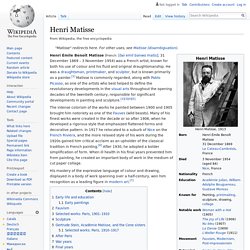
He was a draughtsman, printmaker, and sculptor, but is known primarily as a painter.[1] Matisse is commonly regarded, along with Pablo Picasso, as one of the artists who best helped to define the revolutionary developments in the visual arts throughout the opening decades of the twentieth century, responsible for significant developments in painting and sculpture.[2][3][4][5] The intense colorism of the works he painted between 1900 and 1905 brought him notoriety as one of the Fauves (wild beasts). Many of his finest works were created in the decade or so after 1906, when he developed a rigorous style that emphasized flattened forms and decorative pattern.
Early life and education[edit] Starry Night Over the Rhône. Painting by Vincent van Gogh Starry Night [1] (September 1888, French: La Nuit étoilée), commonly known as Starry Night Over the Rhône, is one of Vincent van Gogh's paintings of Arles at night.
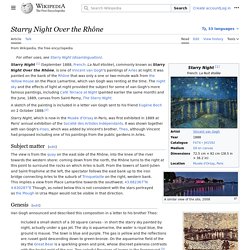
Francisco Goya's Black Paintings. The Black Paintings (Spanish: Pinturas negras) is the name given to a group of fourteen paintings by Francisco Goya from the later years of his life, likely between 1819 and 1823.
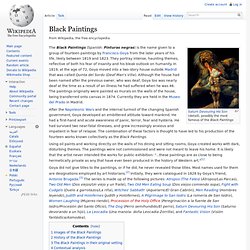
They portray intense, haunting themes, reflective of both his fear of insanity and his bleak outlook on humanity. In 1819, at the age of 72, Goya moved into a two-story house outside Madrid that was called Quinta del Sordo (Deaf Man's Villa). Although the house had been named after the previous owner, who was deaf, Goya too was nearly deaf at the time as a result of an illness he had suffered when he was 46. The paintings originally were painted as murals on the walls of the house, being transferred onto canvas in 1874. Currently they are held in the Museo del Prado in Madrid. The Destroying Angel and Daemons of Evil Interrupting the Orgies of the Vicious and Intemperate.
The Destroying Angel and Daemons of Evil Interrupting the Orgies of the Vicious and Intemperate When first exhibited in 1832, The Destroying Angel was widely praised for its technical brilliance, but critics were divided on the subject matter.
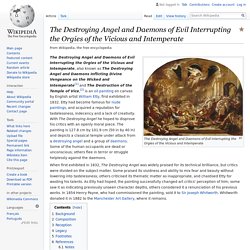
Some praised its vividness and ability to mix fear and beauty without lowering into tastelessness; others criticised its thematic matter as inappropriate, and chastised Etty for wasting his talents. As Etty had hoped, the painting successfully changed art critics' perception of him; some saw it as indicating previously unseen character depths, others considered it a renunciation of his previous works. In 1854 Henry Payne, who had commissioned the painting, sold it to Sir Joseph Whitworth. Whitworth donated it in 1882 to the Manchester Art Gallery, where it remains. Background[edit] Between 1820 and 1829 Etty exhibited 15 paintings, of which 14 depicted nude figures.